ESP FIAT PUNTO 2014 Owner handbook (in English)
[x] Cancel search | Manufacturer: FIAT, Model Year: 2014, Model line: PUNTO, Model: FIAT PUNTO 2014Pages: 219, PDF Size: 3.67 MB
Page 130 of 219
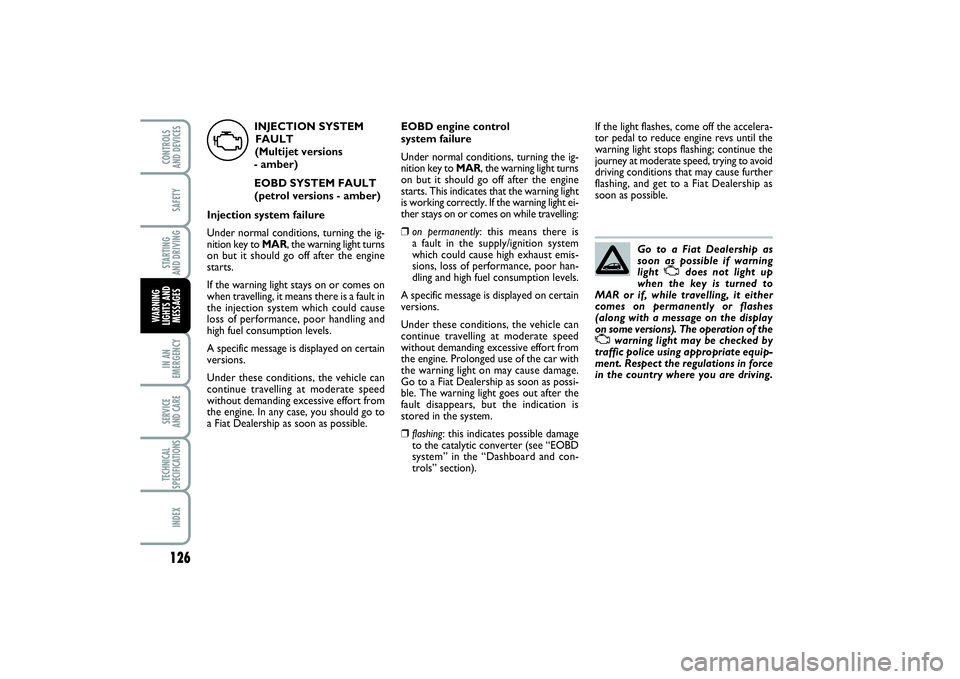
126SAFETYSTARTING
AND DRIVINGIN AN
EMERGENCYSERVICE
AND CARETECHNICAL
SPECIFICATIONSINDEXCONTROLS
AND DEVICESWARNING
LIGHTS AND
MESSAGES
Go to a Fiat Dealership as
soon as possible if warning
light
U
does not light up
when the key is turned to
MAR or if, while travelling, it either
comes on permanently or flashes
(along with a message on the display
on some versions). The operation of the
U
warning light may be checked by
traffic police using appropriate equip-
ment. Respect the regulations in force
in the country where you are driving.
If the light flashes, come off the accelera-
tor pedal to reduce engine revs until the
warning light stops flashing; continue the
journey at moderate speed, trying to avoid
driving conditions that may cause further
flashing, and get to a Fiat Dealership as
soon as possible. EOBD engine control
system failure
Under normal conditions, turning the ig-
nition key to MAR, the warning light turns
on but it should go off after the engine
starts. This indicates that the warning light
is working correctly. If the warning light ei-
ther stays on or comes on while travelling:
❒on permanently: this means there is
a fault in the supply/ignition system
which could cause high exhaust emis-
sions, loss of performance, poor han-
dling and high fuel consumption levels.
A specific message is displayed on certain
versions.
Under these conditions, the vehicle can
continue travelling at moderate speed
without demanding excessive effort from
the engine. Prolonged use of the car with
the warning light on may cause damage.
Go to a Fiat Dealership as soon as possi-
ble. The warning light goes out after the
fault disappears, but the indication is
stored in the system.
❒flashing: this indicates possible damage
to the catalytic converter (see “EOBD
system” in the “Dashboard and con-
trols” section). INJECTION SYSTEM
FAULT
(Multijet versions
- amber)
EOBD SYSTEM FAULT
(petrol versions - amber)
Injection system failure
Under normal conditions, turning the ig-
nition key to MAR, the warning light turns
on but it should go off after the engine
starts.
If the warning light stays on or comes on
when travelling, it means there is a fault in
the injection system which could cause
loss of performance, poor handling and
high fuel consumption levels.
A specific message is displayed on certain
versions.
Under these conditions, the vehicle can
continue travelling at moderate speed
without demanding excessive effort from
the engine. In any case, you should go to
a Fiat Dealership as soon as possible.
U
121-132 PUNTO POP 1ed EN 29/08/13 15.03 Pagina 126
Page 134 of 219
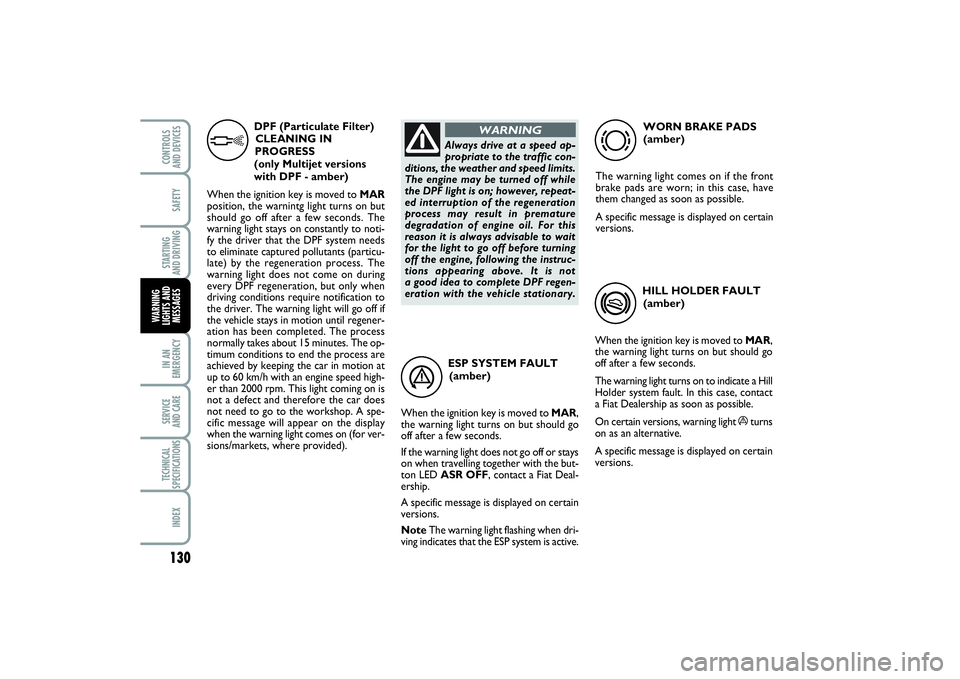
130SAFETYSTARTING
AND DRIVINGIN AN
EMERGENCYSERVICE
AND CARETECHNICAL
SPECIFICATIONSINDEXCONTROLS
AND DEVICESWARNING
LIGHTS AND
MESSAGES
ESP SYSTEM FAULT
(amber)
When the ignition key is moved to MAR,
the warning light turns on but should go
off after a few seconds.
If the warning light does not go off or stays
on when travelling together with the but-
ton LED ASR OFF, contact a Fiat Deal-
ership.
A specific message is displayed on certain
versions.
NoteThe warning light flashing when dri-
ving indicates that the ESP system is active.
á
HILL HOLDER FAULT
(amber)
When the ignition key is moved to MAR,
the warning light turns on but should go
off after a few seconds.
The warning light turns on to indicate a Hill
Holder system fault. In this case, contact
a Fiat Dealership as soon as possible.
On certain versions, warning light
á
turns
on as an alternative.
A specific message is displayed on certain
versions.
*
WORN BRAKE PADS
(amber)
The warning light comes on if the front
brake pads are worn; in this case, have
them changed as soon as possible.
A specific message is displayed on certain
versions.
d
DPF (Particulate Filter)
CLEANING IN
PROGRESS
(only Multijet versions
with DPF - amber)
When the ignition key is moved to MAR
position, the warnintg light turns on but
should go off after a few seconds. The
warning light stays on constantly to noti-
fy the driver that the DPF system needs
to eliminate captured pollutants (particu-
late) by the regeneration process. The
warning light does not come on during
every DPF regeneration, but only when
driving conditions require notification to
the driver. The warning light will go off if
the vehicle stays in motion until regener-
ation has been completed. The process
normally takes about 15 minutes. The op-
timum conditions to end the process are
achieved by keeping the car in motion at
up to 60 km/h with an engine speed high-
er than 2000 rpm. This light coming on is
not a defect and therefore the car does
not need to go to the workshop. A spe-
cific message will appear on the display
when the warning light comes on (for ver-
sions/markets, where provided).
h
Always drive at a speed ap-
propriate to the traffic con-
ditions, the weather and speed limits.
The engine may be turned off while
the DPF light is on; however, repeat-
ed interruption of the regeneration
process may result in premature
degradation of engine oil. For this
reason it is always advisable to wait
for the light to go off before turning
off the engine, following the instruc-
tions appearing above. It is not
a good idea to complete DPF regen-
eration with the vehicle stationary.
WARNING
121-132 PUNTO POP 1ed EN 29/08/13 15.03 Pagina 130
Page 149 of 219

145
SAFETYSTARTING
AND DRIVINGWARNING
LIGHTS AND
MESSAGESSERVICE
AND CARETECHNICAL
SPECIFICATIONSINDEXCONTROLS
AND DEVICESIN AN
EMERGENCY
CHANGING A BULB GENERAL INSTRUCTIONS❒
When a light is not working, check that
the corresponding fuse is intact before
changing the bulb. For the location of
fuses, refer to the “Changing a fuse”
paragraph in this section;
❒
before changing a bulb check the con-
tacts for rusting;
❒
burnt bulbs must be replaced by others
of the same type and wattage;
❒
for safety reasons, always check the di-
rection of the headlight beam after
changing a bulb.
IMPORTANT The internal surface of the
light may appear slightly misty: this does
not indicate a fault, and is actually caused
by low temperature and the degree of hu-
midity in the air. Misting will rapidly dis-
appear when the headlights are switched
on. The presence of drops inside the head-
lights indicates infiltration of water. Go to
a Fiat Dealership.
TYPES OF BULBS
Various types of bulbs are fitted to your
car:
AGlass bulbs: clipped into position. Pull
to remove.BBayonet-type bulbs: to remove from
its holder, press the bulb in and turn
it anti-clockwise.
CTubular bulbs: release them from
their contacts to remove.
D-EHalogen bulbs: to remove the bulb,
release the clip holding the bulb in
place. Halogen bulbs must be han-
dled holding the metallic part
only. Touching the transpar-
ent part of the bulb with your
fingers may reduce the intensity of the
light emitted and even compromise the
longevity of the bulb itself. In the event
of accidental contact, wipe the bulb
with an alcohol-soaked cloth and leave
to dry.
Modifications or repairs to
the electrical system (ECUs)
that are not carried out properly or
do not take the system’s technical
specifications into account can cause
malfunctions leading to the risk of fire.
WARNING
Halogen bulbs contain pres-
surised gas which may cause
small fragments of glass to be pro-
jected outwards if the bulb is broken.
WARNING
fig. 15
F0M0207m
133-164 PUNTO POP 1ed EN 29/08/13 15.07 Pagina 145
Page 157 of 219
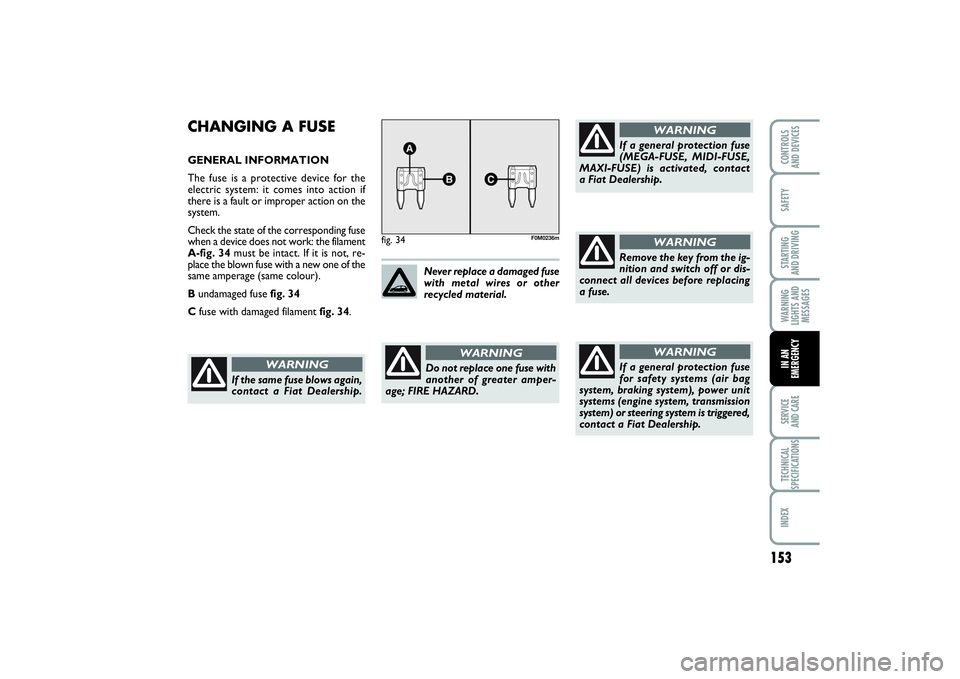
153
SAFETYSTARTING
AND DRIVINGWARNING
LIGHTS AND
MESSAGESSERVICE
AND CARETECHNICAL
SPECIFICATIONSINDEXCONTROLS
AND DEVICESIN AN
EMERGENCY
CHANGING A FUSEGENERAL INFORMATION
The fuse is a protective device for the
electric system: it comes into action if
there is a fault or improper action on the
system.
Check the state of the corresponding fuse
when a device does not work: the filament
A-fig. 34must be intact. If it is not, re-
place the blown fuse with a new one of the
same amperage (same colour).
B undamaged fuse fig. 34
Cfuse with damaged filament fig. 34.
fig. 34
F0M0236m
Do not replace one fuse with
another of greater amper-
age; FIRE HAZARD.
WARNING
Never replace a damaged fuse
with metal wires or other
recycled material.
If a general protection fuse
(MEGA-FUSE, MIDI-FUSE,
MAXI-FUSE) is activated, contact
a Fiat Dealership.
WARNING
If the same fuse blows again,
contact a Fiat Dealership.
WARNING
Remove the key from the ig-
nition and switch off or dis-
connect all devices before replacing
a fuse.
WARNING
If a general protection fuse
for safety systems (air bag
system, braking system), power unit
systems (engine system, transmission
system) or steering system is triggered,
contact a Fiat Dealership.
WARNING
133-164 PUNTO POP 1ed EN 29/08/13 15.07 Pagina 153
Page 164 of 219

160SAFETYSTARTING
AND DRIVINGWARNING
LIGHTS AND
MESSAGESSERVICE
AND CARETECHNICAL
SPECIFICATIONSINDEXCONTROLS
AND DEVICESIN AN
EMERGENCY
17
14
01
03
04
15
10
16
08
07
05
11
13
09
06
02
20
7,5
–
–
–
–
20
–
10
–
15
20
–
10
–
– Boot fusebox fig. 44
DEVICESFUSE AMPSSunroof opening systemAlarm system management control unitSpareSpareSpareSpareElectric windows system (motor, control unit) on right-hand doorSpareDriver’s seat heater control unitTow hook system (capability for after-sale fuse assembly)Boot socketElectric windows system (motor, control unit) on left-hand doorSpare Front passenger seat heater control unitSpareSpare
133-164 PUNTO POP 1ed EN 29/08/13 15.08 Pagina 160
Page 167 of 219
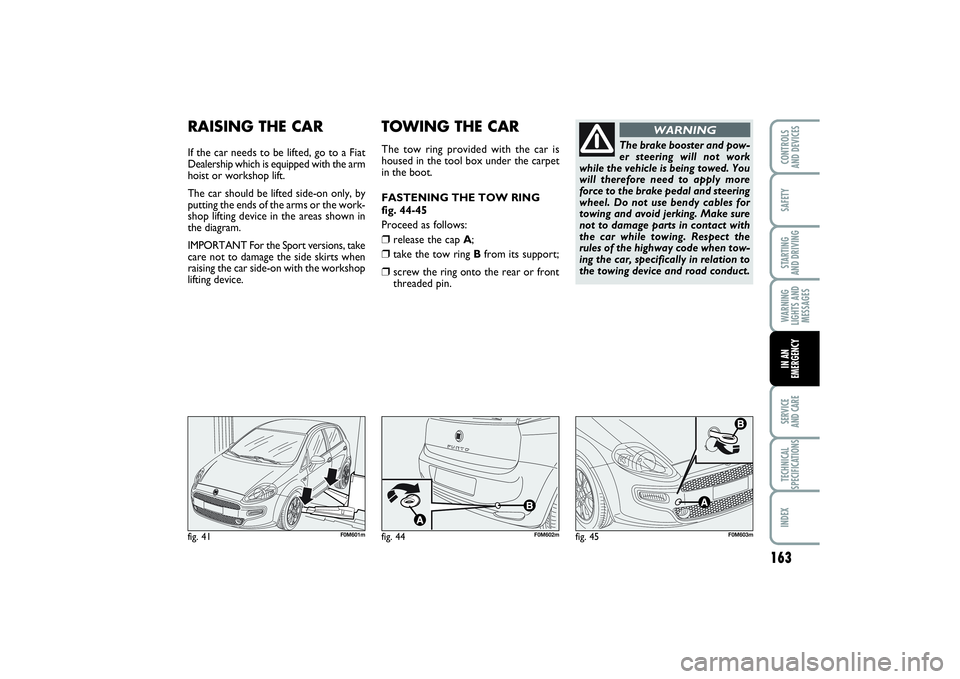
163
SAFETYSTARTING
AND DRIVINGWARNING
LIGHTS AND
MESSAGESSERVICE
AND CARETECHNICAL
SPECIFICATIONSINDEXCONTROLS
AND DEVICESIN AN
EMERGENCY
fig. 41
F0M601m
RAISING THE CARIf the car needs to be lifted, go to a Fiat
Dealership which is equipped with the arm
hoist or workshop lift.
The car should be lifted side-on only, by
putting the ends of the arms or the work-
shop lifting device in the areas shown in
the diagram.
IMPORTANT For the Sport versions, take
care not to damage the side skirts when
raising the car side-on with the workshop
lifting device.
TOWING THE CARThe tow ring provided with the car is
housed in the tool box under the carpet
in the boot.
FASTENING THE TOW RING
fig. 44-45
Proceed as follows:❒
release the cap A;
❒
take the tow ring Bfrom its support;
❒
screw the ring onto the rear or front
threaded pin.
The brake booster and pow-
er steering will not work
while the vehicle is being towed. You
will therefore need to apply more
force to the brake pedal and steering
wheel. Do not use bendy cables for
towing and avoid jerking. Make sure
not to damage parts in contact with
the car while towing. Respect the
rules of the highway code when tow-
ing the car, specifically in relation to
the towing device and road conduct.
WARNING
fig. 44
F0M602m
fig. 45
F0M603m
133-164 PUNTO POP 1ed EN 29/08/13 15.08 Pagina 163
Page 168 of 219

164SAFETYSTARTING
AND DRIVINGWARNING
LIGHTS AND
MESSAGESSERVICE
AND CARETECHNICAL
SPECIFICATIONSINDEXCONTROLS
AND DEVICESIN AN
EMERGENCY
Do not start the engine while
the car is being towed.
WARNING
Clean the threaded housing
carefully before fastening
the ring. Make sure that the ring is se-
curely fastened before towing the car.
WARNING
Release the steering wheel
lock before towing (see “Ig-
nition device” in “Dashboard and
controls”). The brake booster and
power steering will not work while the
vehicle is being towed. You will there-
fore need to apply more force to the
brake pedal and steering wheel. Do
not use bendy cables for towing and
avoid jerking. Make sure not to dam-
age parts in contact with the car
while towing. Respect the rules of the
highway code when towing the car,
specifically in relation to the towing
device and road conduct.
WARNING
The front and rear tow
hooks should be used only
for emergencies on the road. You are
allowed to tow the car for short dis-
tances using an appropriate device in
accordance with the highway code
(a rigid bar), to move the vehicle on
the road in readiness for towing or
transporting via a breakdown vehicle.
Tow hooks MUST NOT be used to
tow vehicles off the road or where
there are obstacles and/or for tow-
ing operations using cables or other
non-rigid devices.
Respecting the above conditions,
towing must take place with two ve-
hicles (one towing, the other towed)
aligned as much as possible along the
same centre line.
WARNING
133-164 PUNTO POP 1ed EN 29/08/13 15.08 Pagina 164
Page 193 of 219
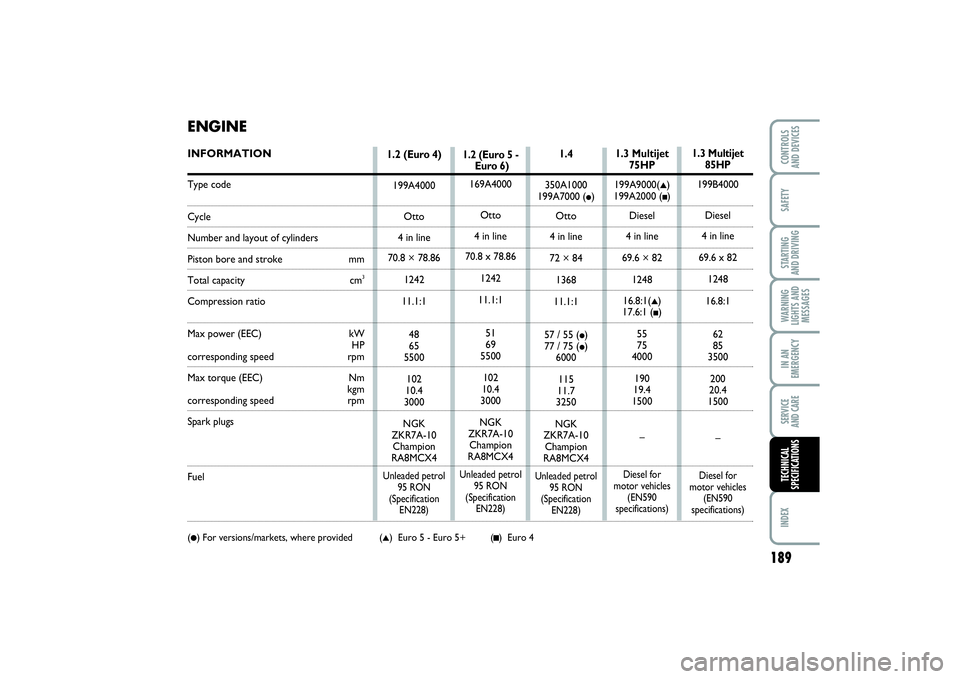
189
SAFETYSTARTING
AND DRIVINGWARNING
LIGHTS AND
MESSAGESIN AN
EMERGENCYSERVICE
AND CAREINDEXCONTROLS
AND DEVICESTECHNICAL
SPECIFICATIONS
ENGINEINFORMATIONType codeCycleNumber and layout of cylindersPiston bore and stroke mmTotal capacity cm
3
Compression ratioMax power (EEC) kW
HPcorresponding speed rpm
Max torque (EEC) Nm
kgmcorresponding speed rpm
Spark plugsFuel (●) For versions/markets, where provided (
▲) Euro 5 - Euro 5+ (
■) Euro 4
1.3 Multijet
75HP199A9000(
▲)
199A2000 (■)
Diesel
4 in line
69.6 × 82
1248
16.8:1(
▲)
17.6:1 (■)
55
75
4000
190
19.4
1500
–
Diesel for
motor vehicles
(EN590
specifications)
1.4
350A1000
199A7000 (
●)
Otto
4 in line
72 × 84
1368
11.1:1
57 / 55 (
●)
77 / 75 (●)
6000
115
11.7
3250
NGK
ZKR7A-10
Champion
RA8MCX4
Unleaded petrol
95 RON
(Specification
EN228)
1.2 (Euro 4)199A4000
Otto
4 in line
70.8 × 78.86
1242
11.1:1
48
65
5500
102
10.4
3000
NGK
ZKR7A-10
Champion
RA8MCX4Unleaded petrol
95 RON
(Specification
EN228)
1.3 Multijet
85HP199B4000
Diesel
4 in line
69.6 x 82
1248
16.8:1
62
85
3500
200
20.4
1500
–Diesel for
motor vehicles
(EN590
specifications)
1.2 (Euro 5 -
Euro 6)169A4000
Otto
4 in line
70.8 x 78.86
1242
11.1:1
51
69
5500
102
10.4
3000
NGK
ZKR7A-10
Champion
RA8MCX4Unleaded petrol
95 RON
(Specification
EN228)
185-208 PUNTO POP 1ed EN 24/09/13 14.26 Pagina 189
Page 197 of 219
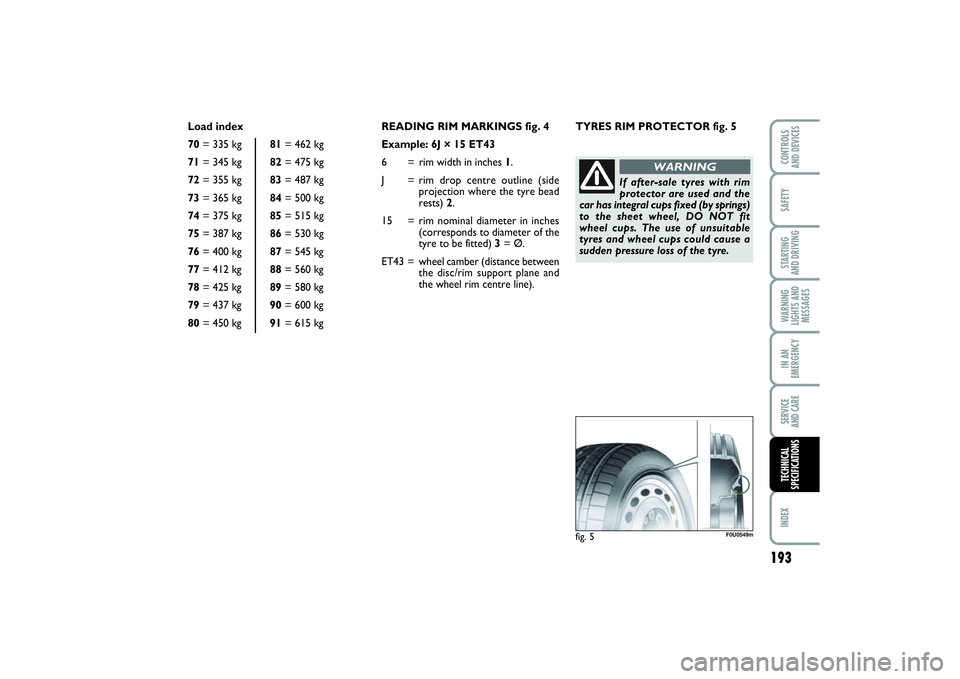
193
SAFETYSTARTING
AND DRIVINGWARNING
LIGHTS AND
MESSAGESIN AN
EMERGENCYSERVICE
AND CAREINDEXCONTROLS
AND DEVICESTECHNICAL
SPECIFICATIONS
READING RIM MARKINGS fig. 4
Example: 6J × 15 ET43
6 = rim width in inches 1.
J = rim drop centre outline (side
projection where the tyre bead
rests) 2.
15 = rim nominal diameter in inches
(corresponds to diameter of the
tyre to be fitted) 3= Ø.
ET43 = wheel camber (distance between
the disc/rim support plane and
the wheel rim centre line). Load index
70= 335 kg 81= 462 kg
71= 345 kg 82= 475 kg
72= 355 kg 83= 487 kg
73= 365 kg 84= 500 kg
74= 375 kg 85= 515 kg
75= 387 kg 86= 530 kg
76= 400 kg 87= 545 kg
77= 412 kg 88= 560 kg
78= 425 kg 89= 580 kg
79= 437 kg 90= 600 kg
80= 450 kg 91= 615 kg
TYRES RIM PROTECTOR fig. 5fig. 5
F0U0549m
If after-sale tyres with rim
protector are used and the
car has integral cups fixed (by springs)
to the sheet wheel, DO NOT fit
wheel cups. The use of unsuitable
tyres and wheel cups could cause a
sudden pressure loss of the tyre.
WARNING
185-208 PUNTO POP 1ed EN 24/09/13 14.26 Pagina 193
Page 201 of 219
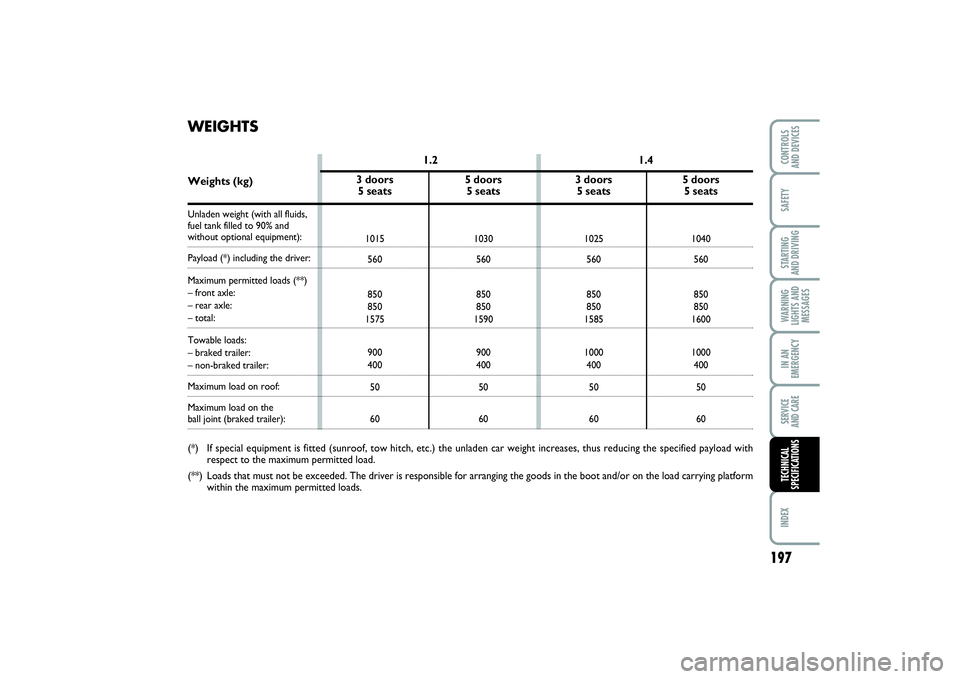
5 doors
5 seats1030
560
850
850
1590
900
400
50
60
3 doors
5 seats1025
560
850
850
1585
1000
400
50
60
5 doors
5 seats1040
560
850
850
1600
1000
400
50
60
197
SAFETYSTARTING
AND DRIVINGWARNING
LIGHTS AND
MESSAGESIN AN
EMERGENCYSERVICE
AND CAREINDEXCONTROLS
AND DEVICESTECHNICAL
SPECIFICATIONS
WEIGHTS
1.2 1.4
Weights (kg)
Unladen weight (with all fluids,
fuel tank filled to 90% and without optional equipment):Payload (*) including the driver:
Maximum permitted loads (**)
– front axle:
– rear axle:– total:
Towable loads:
– braked trailer:– non-braked trailer:Maximum load on roof:
Maximum load on the ball joint (braked trailer):(*) If special equipment is fitted (sunroof, tow hitch, etc.) the unladen car weight increases, thus reducing the specified payload with
respect to the maximum permitted load.
(**) Loads that must not be exceeded. The driver is responsible for arranging the goods in the boot and/or on the load carrying platform
within the maximum permitted loads.
3 doors
5 seats1015
560
850
850
1575
900
400
50
60
185-208 PUNTO POP 1ed EN 24/09/13 14.26 Pagina 197